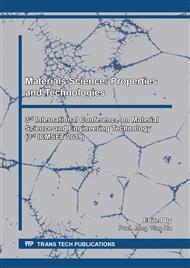[1]
Y. Huang, E. Ma, G. Zhao, Thermal and structure analysis on reaction mechanisms during the preparation of activated carbon fibers by KOH activation from liquefied wood-based fibers, Ind. Crops Prod. 69 (2015) 447-455.
DOI: 10.1016/j.indcrop.2015.03.002
Google Scholar
[2]
H. Jiang, J. Wang, S. Wu, Z. Yuan, Z. Hu, R. Wu, Q. Liu, The pyrolysis mechanism of phenol formaldehyde resin, Polym. Degrad. Stab. 97(8) (2012) 1527-1533.
DOI: 10.1016/j.polymdegradstab.2012.04.016
Google Scholar
[3]
S. Delin, Y. Xianchun, S. Debin, and W. Rong, Woodceramics Prepared form Liquefaction Wood and Wood Powder, Appl. Mech. Mater. 190 (2012) 585-589.
DOI: 10.4028/www.scientific.net/amm.190-191.585
Google Scholar
[4]
M. Kobayashi, T. Asano, M. Kajiyama, B. Tomita, Analysis on residue formation during wood liquefaction with polyhydric alcohol, J. Wood Sci. 50(5) (2004) 407-414.
DOI: 10.1007/s10086-003-0596-9
Google Scholar
[5]
L. Lin, Y. Yao, M. Yoshioka, N. Shiraishi, Liquefaction mechanism of cellulose in the presence of phenol under acid catalysis, Carbohydr. Polym. 57(2) (2004) 123-129.
DOI: 10.1016/j.carbpol.2004.01.014
Google Scholar
[6]
E. Jasiukaitytė, M. Kunaver, M. Strlič, Cellulose liquefaction in acidified ethylene glycol, Cellulose, 16(3) (2009) 393-405.
DOI: 10.1007/s10570-009-9288-y
Google Scholar
[7]
M.H. Alma, M.A. Basturk, Liquefaction of grapevine cane (Vitis vinisera L.) waste and its application to phenol–formaldehyde type adhesive, Ind. Crops Prod. 24 (2006) 171-176.
DOI: 10.1016/j.indcrop.2006.03.010
Google Scholar
[8]
T. Yamada, H. Ono, Characterization of the products resulting from ethylene glycol liquefaction of cellulose, J. Wood Sci. 47(6) (2001) 458-464.
DOI: 10.1007/bf00767898
Google Scholar
[9]
H. Pan, Wood liquefaction in the presence of phenol with a weak acid catalyst and its potential for novolac type wood adhesives, Doctor of Philosophy, Graduate Faculty of the Louisiana State, The School of Renewable Natural Resources Graduate Faculty of the Louisiana State, (2007).
DOI: 10.31390/gradschool_dissertations.525
Google Scholar
[10]
H.M. Cheng, H. Endo, T. Okabe, K. Saito, and G.B. Zheng, Graphitization Behavior of Wood Ceramics and Bamboo Ceramics as Determined by X-Ray Diffraction, J. Porous Mater. 6 (1999) 233-237.
Google Scholar
[11]
L. Lin, M. Yoshioka, Y. Yao, N. Shiraishi, Liquefaction of wood in the presence of phenol using phosphoric acid as a catalyst and the flow properties of the liquefied wood, J. Appl. Polym. Sci. 52(11) (1994) 1629-1636.
DOI: 10.1002/app.1994.070521111
Google Scholar
[12]
C.P. Reghunadhan Nair, R.L. Bindu, and K.N. Ninan, Thermal characteristics of addition-cure phenolic resins, Polym. Degradat. Stabil. 73 (2001) 251-257.
DOI: 10.1016/s0141-3910(01)00076-3
Google Scholar
[13]
J. Qian, Z. Jin, and J. Wang, Structure and basic properties of woodceramics made from phenolic resin–basswood powder composite, Mater. Sci. Eng.: A 368 (2004) 71-79.
DOI: 10.1016/j.msea.2003.09.081
Google Scholar


